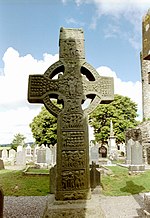 | A Pictish stone is a type of monumental stele, generally carved or incised with symbols or designs. A few have ogham inscriptions. Located in Scotland... 27 KB (2,905 words) - 15:51, 16 December 2023 |
 | Picts (redirect from Pictish studies) details of their culture can be gleaned from early medieval texts and Pictish stones. The name Picti appears in written records as an exonym from the late... 74 KB (8,038 words) - 20:47, 29 April 2024 |
 | The Pictish Beast (sometimes Pictish Dragon or Pictish Elephant) is an artistic representation of an animal depicted on Pictish symbol stones. The Pictish... 3 KB (273 words) - 20:29, 5 May 2024 |
Pictish is an extinct Brittonic Celtic language spoken by the Picts, the people of eastern and northern Scotland from Late Antiquity to the Early Middle... 41 KB (3,958 words) - 20:51, 23 April 2024 |
 | spirits was a feature of Pictish paganism. Roman mentions of the worship of the Goddess Minerva at wells and a Pictish stone associated with a well near... 76 KB (10,594 words) - 14:56, 19 March 2024 |
The Aberlemno Sculptured Stones are a series of Pictish standing stones originating in and around the village of Aberlemno, Angus, Scotland. Three are... 21 KB (2,329 words) - 09:07, 14 March 2024 |
double disc is a Pictish symbol of unknown meaning that is frequently found on Class I and Class II Pictish stones, as well as on Pictish metalwork. The... 3 KB (240 words) - 06:17, 17 April 2023 |
 | The Nigg Stone is an incomplete Class II Pictish cross-slab, perhaps dating to the end of the 8th century. The stone was originally located at the gateway... 4 KB (427 words) - 10:59, 15 April 2024 |
 | Hippocampus (mythology) (section Pictish) The sea-horse also appears in Pictish stone carvings in Scotland. The symbolism of the carving (also known as "Pictish Beast" or "Kelpie") is unknown... 14 KB (1,657 words) - 15:51, 9 April 2024 |
include Neolithic Standing stones and Stone Circles, Bronze Age settlements, Iron Age Brochs and Crannogs, Pictish stones, Roman forts and camps, Viking... 3 KB (156 words) - 06:46, 13 November 2022 |
 | which no doubt gives a very unrepresentative picture, but apart from Pictish stones and the Insular high crosses, large monumental sculpture, even with... 52 KB (6,845 words) - 18:29, 18 April 2024 |
 | The Drosten Stone is a carved Pictish stone of the 9th century at St Vigeans, near Arbroath, Scotland. In academic contexts it is sometimes called St... 4 KB (300 words) - 19:04, 14 February 2024 |
 | / 57.312; -2.493 The Maiden Stone, also known as the Drumdurno Stone after the nearby farm, is a Pictish standing stone near Inverurie in Aberdeenshire... 4 KB (463 words) - 16:56, 16 November 2023 |
Uurad (category Pictish monarchs) Drosten Stone would make Ferat one of only two Pictish monarchs, the other being Caustantín mac Fergusa, whose name is read on a Pictish stone. One version... 2 KB (217 words) - 14:40, 19 April 2022 |
 | The Bullion Stone is a late carved Pictish stone, which is unusual in containing a figure; it dates to c. 900–950. It was discovered in 1933 at Bullion... 2 KB (189 words) - 10:01, 23 March 2024 |
The triple disc is a Pictish symbol of unknown meaning, that is found on Class I and Class II Pictish stones. The symbol is found in various combinations... 1,001 bytes (93 words) - 20:52, 27 February 2023 |
crescent is a Pictish symbol of unknown meaning, that is generally found in combination with an overlaid V-rod on Class I and Class II Pictish stones and infrequently... 1 KB (128 words) - 11:07, 27 February 2023 |
 | Rosemarkie (section Pictish stones) Rosemarkie is probably best known for its collection of finely carved Pictish stones, which is one of the largest in Scotland at a single site. These 8th-9th-century... 5 KB (387 words) - 16:11, 18 June 2022 |
carved Pictish stone known as the Glamis Manse Stone. There are various other Pictish stones nearby the village, such as the Hunter's Hill Stone, and the... 7 KB (688 words) - 17:23, 25 November 2023 |
 | The Hilton of Cadboll Stone is a Class II Pictish stone discovered at Hilton of Cadboll, on the East coast of the Tarbat Peninsula in Easter Ross, Scotland... 6 KB (783 words) - 23:07, 13 April 2024 |
 | The Woodwrae Stone (alternatively the Woodwray Stone) is a Class II Pictish Stone (c. 8th or 9th century) that was found in 1819 when the foundations of... 8 KB (748 words) - 12:54, 17 April 2023 |
The mirror and comb are Pictish symbols of uncertain function, found on Class I and Class II Pictish stones. The mirror, or mirror and comb, do not belong... 2 KB (208 words) - 11:15, 27 February 2023 |








